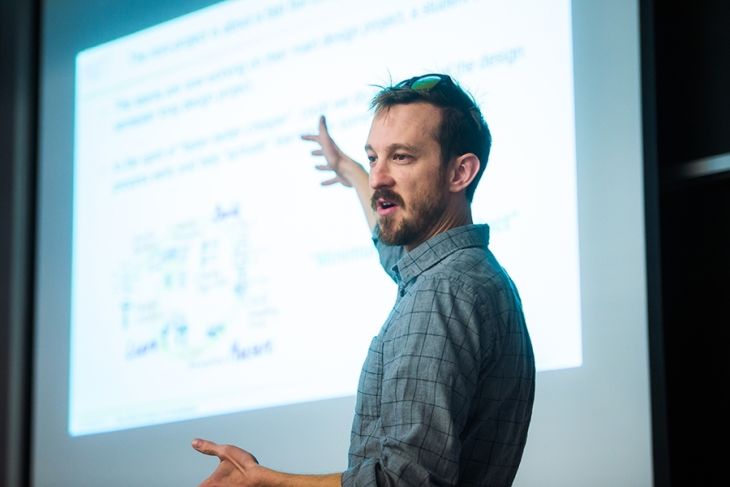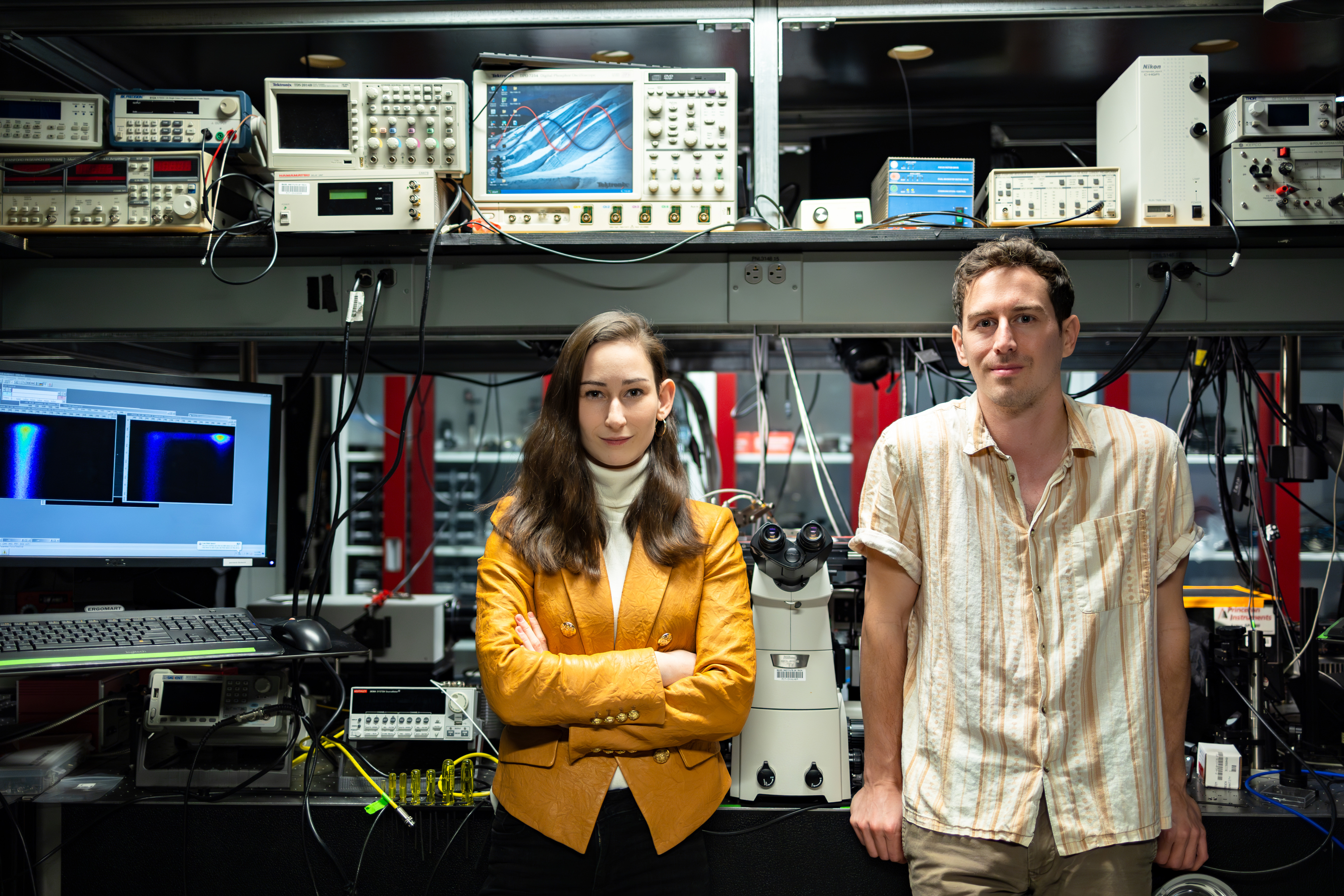Last fall, a team of five senior undergraduate nuclear engineering students met once a week for dinners where they took turns cooking and debated how to tackle a particularly daunting challenge set forth in their program’s capstone course, 22.033 (Nuclear Systems Design Project).
In past semesters, students had free reign to identify any real-world problem that interested them to solve through team-driven prototyping and design. This past fall worked a little differently. The team continued the trend of tackling daunting problems, but instead got an assignment to explore a particular design challenge on MIT’s campus. Rising to the challenge, the team spent the semester seeking a feasible way to introduce a highly coveted technology at MIT.
Housed inside a big blue dome is the MIT Nuclear Reactor Laboratory (NRL). The reactor is used to conduct a wide range of science experiments, but in recent years, there have been multiple attempts to implement an instrument at the reactor that could probe the structure of materials, molecules, and devices. With this technology, researchers could model the structure of a wide range of materials and complex liquids made of polymers or containing nanoscale inhomogeneities that differ from the larger mass. On campus, researchers for the first time could conduct experiments to better understand the properties and functions of anything placed in front of a neutron beam emanating from the reactor core.
The impact of this would be immense. If the reactor could be adapted to conduct this advanced technique, known as small-angle neutron scattering (SANS), it would open up a whole new world of research at MIT.
“It's essentially using the nuclear reactor as an incredibly high-performance camera that researchers from all over MIT would be very interested in using, including nuclear science and engineering, chemical engineering, biological engineering, and materials science, who currently use this tool at other institutions,” says Zachary Hartwig, Nuclear Systems Design Project professor and the MIT Robert N. Noyce Career Development Professor.
SANS instruments have been installed at fewer than 20 facilities worldwide, and MIT researchers have previously considered implementing the capability at the reactor to help MIT expand community-wide access to SANS. Last fall, this mission went from long-time campus dream to potential reality as it became the design challenge that Hartwig’s students confronted. Despite having no experience with SANS, the team embraced the challenge, taking the first steps to figure out how to bring this technology to campus.
“I really loved the idea that what we were doing could have a very real impact,” says Zoe Fisher, Nuclear Systems Design Project team member and now graduate nuclear engineering student.
Each fall, Hartwig uses the course to introduce students to real-world challenges with strict constraints on solutions, and last fall’s project came with plenty of thorny design questions for students to tackle. First was the size limitation posed by the space available at MIT’s reactor. In SANS facilities around the world, the average length of the instrument is 30 meters, but at NRL, the space available is approximately 7.5 meters. Second, these instruments can cost up to $30 million, which is far outside NRL’s proposed budget of $3 million. That meant not only did students need to design an instrument that would work in a smaller space, but also one that could be built for a tenth of the typical cost.
“The challenge was not just implementing one of these instruments,” Hartwig says. “It was whether the students could significantly innovate beyond the ‘traditional’ approach to doing SANS to meet the daunting constraints that we have at the MIT Reactor.”
Because NRL actually wants to pursue this project, the students had to get creative, and their creative potential was precisely why the idea arose to get them involved, says Jacopo Buongiorno, the director of science and technology at NRL and Tokyo Electric Power Company Professor in Nuclear Engineering. “Involvement in real-world projects that answer questions about feasibility and cost of new technology and capabilities is a key element of a successful undergraduate education at MIT,” Buongiorno says.
Students say it would have been impossible to tackle the problem without the help of co-instructor Boris Khaykovich, a research scientist at NRL who specializes in neutron instrumentation.
Over the past two decades, Khaykovich has watched as SANS became the most popular technique for analyzing material structure. As the amount of available SANS beam time at the few facilities that exist became more competitive, access declined. Today only the experiments passing the most stringent review get access. What Khaykovich hopes to bring to MIT is improved access to SANS by designing an instrument that will be suitable for a majority of run-of-the-mill experiments, even if it’s not as powerful as state-of-the-art national SANS facilities. Such an instrument can still serve a wider range of researchers who currently have few opportunities to pursue SANS experiments.
“In the U.S., we don't have a simple, small, day-to-day SANS instrument,” Khaykovich says.
With Khaykovich’s help, nuclear engineering undergraduate student Liam Hines says his team was able to go much further with their assessment than they would’ve starting from scratch, with no background in SANS. This project was unlike anything they’d ever been asked of as MIT students, and for students like Hines, who contributed to NRL research his entire time on campus, it was a project that hit close to home. “We were imagining this thing that might be designed at MIT,” Hines says.
Fisher and Hines were joined by undergraduate nuclear engineering student team members Francisco Arellano, Jovier Jimenez, and Brendan Vaughan. Together, they devised a design that surprised both Khaykovich and Hartwig, identifying creative solutions that overcame all limitations and significantly reduced cost.
Their team’s final project featured an adaptation of a conical design that was recently experimentally tested in Japan, but not generally used. The conical design allowed them to maximize precision while working within the other constraints, resulting in an instrument design that exceeded Hartwig’s expectations. The students also showed the feasibility of using an alternative type of glass-based low-cost neutron detector to calibrate the scattering data. By avoiding the need for a traditional detector based on helium-3, which is increasingly scarce and exorbitantly expensive, such a detector would dramatically reduce cost and increase availability. Their final presentation indicated the day-to-day SANS instrument could be built at only 4.5 meters long and with an estimated cost less than $1 million.
Khaykovich credited the students for their enthusiasm, bouncing ideas off each other and exploring as much terrain as possible by interviewing experts who implemented SANS at other facilities. “They showed quite a perseverance and an ability to go deep into a very unfamiliar territory for them,” Khaykovich says.
Hines says that Hartwig emphasized the importance of fielding expert opinions to more quickly discover optimal solutions. Fisher says that based on their research, if their design is funded, it would make SANS “more accessible to research for the sake of knowledge,” rather than dominated by industry research.
Hartwig and Khaykovich agreed the students’ final project results showed a baseline of how MIT could pursue SANS technology cheaply, and when NRL proceeds with its own design process, Hartwig says, “The student’s work might actually change the cost of the feasibility of this at MIT in a way that if we hadn't run the class, we would never have thought about doing.”
Buongiorno says as they move forward with the project, NRL staff will consult students’ findings.
“Indeed, the students developed original technical approaches, which are now being further explored by the NRL staff and may ultimately lead to the deployment of this new important capability on the MIT campus," Buongiorno says.
Hartwig says it’s a goal of the Nuclear Systems Design Project course to empower students to learn how to lead teams and embrace challenges, so they can be effective leaders advancing novel solutions in research and industry. “I think it helps teach people to be agile, to be flexible, to have confidence that they can actually go off and learn what they don't know and solve problems they may think are bigger than themselves,” he says.
It's common for past classes of Nuclear Systems Design Project students to continue working on ideas beyond the course, and some students have even launched companies from their project research. What’s less common is for Hartwig’s students to actively serve as engineers pointed to a particular campus problem that’s expected to be resolved in the next few years.
“In this case, they're actually working on something real,” Hartwig says. “Their ideas are going to very much influence what we hope will be a facility that gets built at the reactor.”
For students, it was exciting to inform a major instrument proposal that will soon be submitted to federal funding agencies, and for Hines, it became a chance to make his mark at NRL.
“This is a lab I've been contributing to my entire time at MIT, and then through this project, I finished my time at MIT contributing in a much larger sense,” Hines says.







